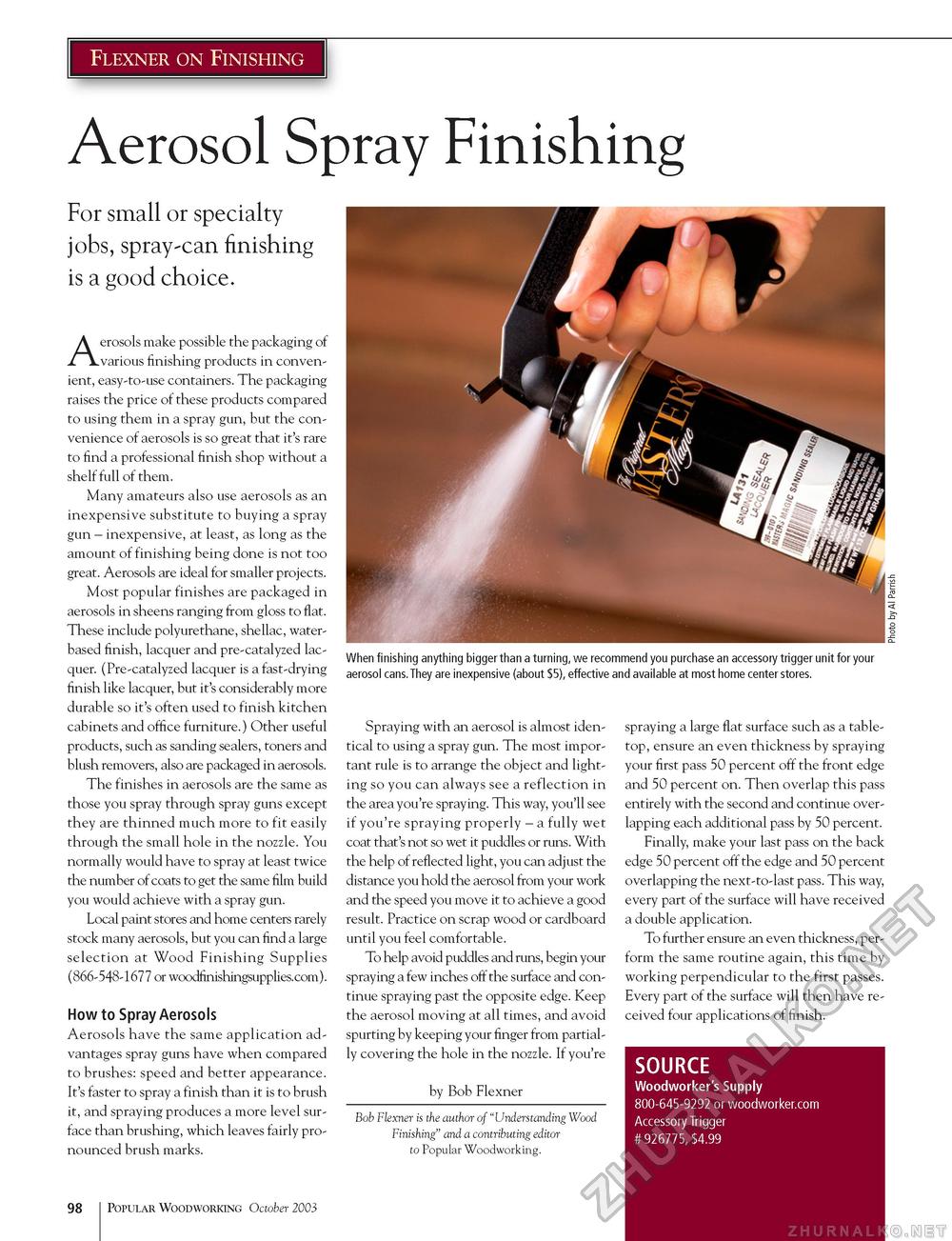Popular Woodworking 2003-10 № 136, страница 98
Flexner on Finishing Aerosol Spray FinishingFor small or specialty jobs, spray-can finishing is a good choice. Aerosols make possible the packaging of various finishing products in convenient, easy-to-use containers. The packaging raises the price of these products compared to using them in a spray gun, but the convenience of aerosols is so great that it's rare to find a professional finish shop without a shelf full of them. Many amateurs also use aerosols as an inexpensive substitute to buying a spray gun - inexpensive, at least, as long as the amount of finishing being done is not too great. Aerosols are ideal for smaller projects. Most popular finishes are packaged in aerosols in sheens ranging from gloss to flat. These include polyurethane, shellac, water-based finish, lacquer and pre-catalyzed lacquer. (Pre-catalyzed lacquer is a fast-drying finish like lacquer, but it's considerably more durable so it's often used to finish kitchen cabinets and office furniture.) Other useful products, such as sanding sealers, toners and blush removers, also are packaged in aerosols. The finishes in aerosols are the same as those you spray through spray guns except they are thinned much more to fit easily through the small hole in the nozzle. You normally would have to spray at least twice the number of coats to get the same film build you would achieve with a spray gun. Local paint stores and home centers rarely stock many aerosols, but you can find a large selection at Wood Finishing Supplies (866-548-1677 or woodfinishingsupplies.com). How to Spray Aerosols Aerosols have the same application advantages spray guns have when compared to brushes: speed and better appearance. It's faster to spray a finish than it is to brush it, and spraying produces a more level surface than brushing, which leaves fairly pronounced brush marks. When finishing anything bigger than a turning, we recommend you purchase an accessory trigger unit for your aerosol cans. They are inexpensive (about $5), effective and available at most home center stores. Spraying with an aerosol is almost identical to using a spray gun. The most important rule is to arrange the object and lighting so you can always see a reflection in the area you're spraying. This way, you'll see if you're spraying properly - a fully wet coat that's not so wet it puddles or runs. With the help of reflected light, you can adjust the distance you hold the aerosol from your work and the speed you move it to achieve a good result. Practice on scrap wood or cardboard until you feel comfortable. To help avoid puddles and runs, begin your spraying a few inches off the surface and continue spraying past the opposite edge. Keep the aerosol moving at all times, and avoid spurting by keeping your finger from partially covering the hole in the nozzle. If you're by Bob Flexner Bob Flexner is the author of "Understanding Wood Finishing" and a contributing editor to Popular Woodworking. spraying a large flat surface such as a table-top, ensure an even thickness by spraying your first pass 50 percent off the front edge and 50 percent on. Then overlap this pass entirely with the second and continue overlapping each additional pass by 50 percent. Finally, make your last pass on the back edge 50 percent off the edge and 50 percent overlapping the next-to-last pass. This way, every part of the surface will have received a double application. To further ensure an even thickness, perform the same routine again, this time by working perpendicular to the first passes. Every part of the surface will then have received four applications of finish. SOURCE Woodworker's Supply 800-645-9292 or woodworker.com Accessory Trigger # 926775, $4.99 98 Popular Woodworking October 2003 |








